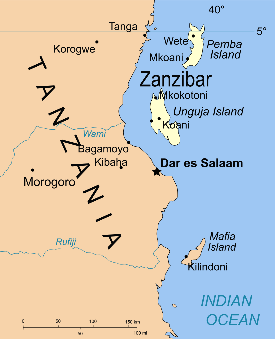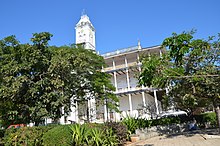Zanzibar
| Zanzibar (Zanzibar) | |
|---|---|

|
|
| Flag of Zanzibar | |
| geography | |
| Country: | Tanzania |
| Waters: | Indian Ocean |
| Islands: | 2 main islands |
| Geographical location: | 6 ° 8 ′ S , 39 ° 20 ′ E |
| Basic data | |
| Surface: | 2654 km² |
| Residents: | 1,155,065 |
| Population density: | 435 inhabitants / km² |
| Capital: | Zanzibar City |
| Situation map | |
Zanzibar [ ˈzanzibaːɐ̯ ] ( English Zanzibar ; Arabic زنجبار, DMG Zanǧi-bār ; Meaning probably "coast of the blacks", cf. Zandsch ) is a semi-autonomous state of the Union state of Tanzania in East Africa.
geography
The area consists of the two neighboring islands of Unguja (formerly also called Zanzibar) and Pemba , each with minor islands , as well as the remote, small Latham Island , all in the Zanzibar archipelago .
The island Mafia in the far south, which is also geographically part of the Zanzibar Archipelago , is not part of the area, but until 1885 it belonged to the Sultanate of Zanzibar .
In 2007 the total population was 1,155,065.
The fauna of Unguja documents the island's land bridge to the African continent during the last ice age. The Zanzibar leopard was one of the endemic subspecies that formed as a new species on the island. Around the island there are coral reefs and seagrass meadows near the coast.
The Tanzanian Wildlife Act includes the flora and fauna of Zanzibar.
history
With the treaty between the German Empire and the United Kingdom over the colonies and Heligoland of 1890, Zanzibar became British.
On December 10, 1963, the sultanate and then the British protectorate of Zanzibar gained independence.
On January 12, 1964, the People's Republic of Zanzibar and Pemba was proclaimed. After a bloody revolution of the black majority population against the Arab-born upper class - the islands had been part of the Sultanate of Oman from 1698 to April 6, 1861 - Zanzibar declared itself independent and soon tended to become a socialist camp.
Under strong political pressure from outside, Zanzibar and the independent Tanganyika merged on April 26, 1964, initially under the name United Republic of Tanganyika and Zanzibar . The republic was then renamed the United Republic of Tanzania about six months later on November 1, 1964 .
administration
As a part of Tanzania, Zanzibar has its own government, parliament and president ( Ali Mohamed Shein since November 2010 ). Its highest court is not subordinate to the highest court of the Union of Tanzania.
The area comprises five of Tanzania's 30 administrative regions (mkoa), two on the island of Pemba and three on the main island of Unguja :
| Region ( mkoa ) | Swahili | Capital | Area km² |
Population 2007 |
|---|---|---|---|---|
| Pemba North | Kaskazini Pemba | Wete | 574 | 224,951 |
| Pemba South | Kusini Pemba | Mkoani | 332 | 216.479 |
| Zanzibar North | Kaskazini Unguja | Mkokotoni | 470 | 160,463 |
| Zanzibar Central / South | Kusini Unguja | Koani | 854 | 105,456 |
| Zanzibar Urban / West | Mjini Magharibi | Zanzibar City | 224 | 447.716 |
| Zanzibar | Zanzibar | Zanzibar City | ... | 1,155,065 |
Each of these regions is in turn divided into two districts (wilaya) , so there are a total of ten districts.
The districts are also divided into wards (shehia) . Several wards each form a constituency .
In rural areas there are villages at the lowest level . A ward can have one or more villages. In urban areas, a ward is a district.
Living standards and health
The average annual income is 250 US dollars . Over half of the population lives below the poverty line . The infant mortality rate in Zanzibar is 54 out of 1,000 live births. It is estimated that around 12% of children suffer from acute malnutrition.
Life expectancy at birth was 54 years in 2010. This value was below the then global average of 67 years.
Infrastructure and transport
Zanzibar's road network has a total length of 1,600 kilometers, of which the most important connections are asphalted or partially asphalted. The remaining roads are gravel or unpaved and are repaired irregularly.
There is no public transport in Zanzibar; however, there are private collective taxis known as Daladala .
Since the end of the 1980s, Zanzibar has developed very good transport links, mostly private operators, on the waterway between the two main islands and to Dar es Salaam , through which over 90% of trade is carried out. There are five ports on Unguja and Pemba where both cargo ships and private boats can dock. The Zanzibar-Port Corporation (ZPC) is a public institution that operates and develops the ports autonomously. The quay walls of the most important sea ports in Zanzibar were built between 1989 and 1991 with financial support from the then European Economic Community .
Zanzibar's main airport, Zanzibar International Airport , is located near Zanzibar City. From there there are regular connections to the mainland, to Pemba as well as to Europe and Asia, which led to an increase in tourism on the islands.
Culture
Language and origin
The inhabitants of Zanzibar are of different ethnic origins, including the Shirazi people . The population speaks Swahili , which as in large areas of East Africa lingua franca used. The official languages are Swahili and English . Arabic is also spoken in many areas .
media
The TV operator in Zanzibar is called Television Zanzibar (TVZ).
Sports
Football is the most popular sport in Zanzibar; the umbrella organization is called the Zanzibar Football Association . This organization is a member of the Confederation of African Football (CAF), but not a FIFA member, which is why the team cannot participate in World Cups. In 1981 its own league was founded.
religion

More than 99% of the population of Zanzibar are Muslim. Sufi orders are widespread among Muslims . The Qādirīya is still the most popular Tarīqa in the urban and rural milieus of Zanzibar. Other orders that have a larger following in Zanzibar are the Shādhilīya , the Rifāʿīya , the Ahmadīya Dandarāwīya, the Naqschbandīya and the Tarīqa ʿAlawīya . In the 19th century, the Shādhilīya was still the numerically strongest brotherhood. It was particularly widespread among the Comorian immigrants who flocked to Zanzibar around the middle of the century.
literature
- Rita Bake (ed.): Hamburg - Sansibar, Sansibar - Hamburg: Hamburg's connections to East Africa since the middle of the 19th century. State Center for Political Education, Hamburg 2009, ISBN 3-929728-19-2 .
- Colette Le Cour Grandmaison, Ariel Crozon: Zanzibar aujourd'hui. Karthala, Paris 1998, ISBN 2-86537-792-X .
- Amina Ameir Issa: The Legacy of Qādirī Scholars in Zanzibar. In: Roman Loimeier, Rüdiger Sesemann (Ed.): The Global Worlds of the Swahili. Interfaces of Islam, Identity and Space in 19th and 20th-Century East Africa. Lit, Berlin / Münster 2006, ISBN 978-3-8258-9769-7 , pp. 343-361.
- Sascha Wisotzki: Zanzibar: 1000 years of globalization. Edition Weiss, Berlin 2009, ISBN 978-3-9811876-2-5 .
Web links
Individual evidence
- ^ A b c Revolutionary Government of Zanzibar, Office of Chief Government Statistician: Zanzibar Statistical Abstract 2007. ( Memento of February 10, 2012 in the Internet Archive ). May 2008 (PDF).
-
↑ Country lexicon: Zanzibar, history. ( Memento of April 30, 2011 in the Internet Archive ).
Rainer Achim Blasius, Wolfgang Hölscher, Daniel Kosthorst: Files on the Foreign Policy of the Federal Republic of Germany, 1964, Volume 1. de Gruyter, Oldenbourg, Berlin, 1997, ISBN 978-3-486-56065-7 ( limited preview in the Google book search ). - ^ Tanzania Government: Tanzania: Public Administration. ( Memento of November 13, 2013 in the Internet Archive ).
- ↑ Local Governance in Zanzibar. From: Per Tidem: Zanzibar Good Governance Strategy. April 2003 (PDF; 480 kB).
- ^ Supporting treatment of childhood malnutrition in Zanzibar. World Health Organization Report on Malnutrition, 2013 (PDF).
- ^ International Labor Office, Social Security Department: Zanzibar: Social Protection Expenditures and Performance Review and Social Budget. Geneva, January 2010, p. 22.
- ^ Central Intelligence Agency : The World Factbook: Tanzania. Retrieved December 26, 2015.
- ^ Cf. Issa: The Legacy of Qādirī Scholars. 2006, p. 348.
- ^ Cf. Issa: The Legacy of Qādirī Scholars. 2006, p. 346.


